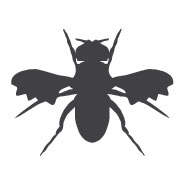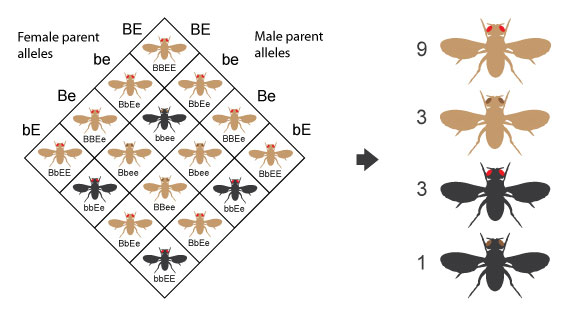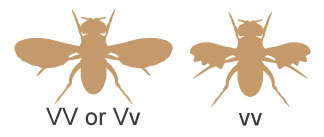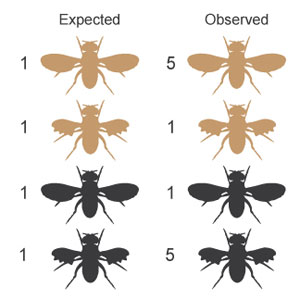« Prev Next »

Some Genes Are Transmitted to Offspring in Groups via the Phenomenon of Gene Linkage

Indeed, shortly after Mendel's discoveries about inheritance patterns became widely known, numerous researchers began to notice exceptions to his principles. For example, they realized that some crosses contradicted Mendel's principle of independent assortment, because these crosses produced organisms with certain phenotypes far more frequently than traditional Mendelian genetics predicted.
Based on these findings, these scientists hypothesized that certain alleles of one gene were somehow coupled with certain alleles of another gene; however, they were not sure how this could occur. This phenomenon is now known as genetic linkage, and it generally describes an inheritance pattern in which two genes located in close proximity to each other on the same chromosome have a biased association between their alleles. This, in turn, causes these alleles to be inherited together instead of assorting independently. Genetic linkage is a violation of the Mendelian principle of independent assortment.
Independent assortment in test crosses
To understand linkage, we must first compare it to an example of independent assortment of parental gametes. The best way to generate such an example is through a dihybrid test cross, which considers two different genes during a cross between two heterozygote parents. Mendel's principle of independent assortment predicts that the alleles of the two genes will be independently distributed into gametes.
Thus, according to Mendel's principles, a dihybrid cross between two heterozygous fruit flies with brown bodies and red eyes (BbEe X BbEe) should yield offspring with nine possible genotypes (BBEE, BBEe, BBee, BbEE, BbEe, Bbee, bbEE, bbEe, and bbee) and four possible phenotypes (brown body with red eyes, brown body with brown eyes, black body with red eyes, and black body with brown eyes) (Figure 1, left). In this case, the ratio of phenotypes observed among the offspring is 9 (brown body, red eyes): 3 (brown body, brown eyes): 3 (black body, red eyes): 1 (black body, brown eyes) (Figure 1, right). This 9:3:3:1 phenotypic ratio is the classic Mendelian ratio for a dihybrid cross in which the alleles of two different genes assort independently into gametes.


Exceptions to independent assortment


What is the reason for this 5:1:1:5 non-Mendelian phenotypic ratio? It turns out that the body color and wing length genes are linked, which means they are located very close to each other on the same chromosome. The consequence of this is that these gene alleles are much less likely to segregate independently into gametes. In addition, if two genes are linked in this way, then gametes are more likely to contain specific allele combinations. In this example, those combinations of alleles are BV and bv. As such, the heterozygous parent produces more BV and bv gametes than Bv and bV gametes. (Recall that the homozygous parent can only produce bv gametes.) This is why, when the BbVv fly is crossed with the bbvv fly, the resulting offspring are more likely to have BbVv and bbvv genotypes than Bbvv and bbVv genotypes, and the observed phenotypic ratio is 5:1:1:5. In fact, because the alleles do not assort independently into gametes during meiosis, Punnett squares like the ones shown in Figures 2 and 3 cannot be used to accurately predict inheritance patterns for crosses involving linked genes.
To return to the fruit fly example, linkage means that the BbVv parent is more likely to produce gametes that match those contributed by its own parents: BV and bv. Therefore, offspring with parental genotypes (BbVv and bbvv) are more common than offspring with non-parental, or recombinant, genotypes (Bbvv and bbVv) after the test cross. This means the parental genotypes and their corresponding phenotypes are observed five times more often than the recombinant genotypes and their corresponding phenotypes.
Summary
Make your own fly
Breeding flies is an exciting way to learn genetics. There are many possible allele combinations within a fruit fly, and you can explore them via the interactive image below. Just click on a genotype button from each category below to make your own customized fly (Drosophila melanogaster).
Further Exploration
Key Questions
eBooks
This page appears in the following eBook





















